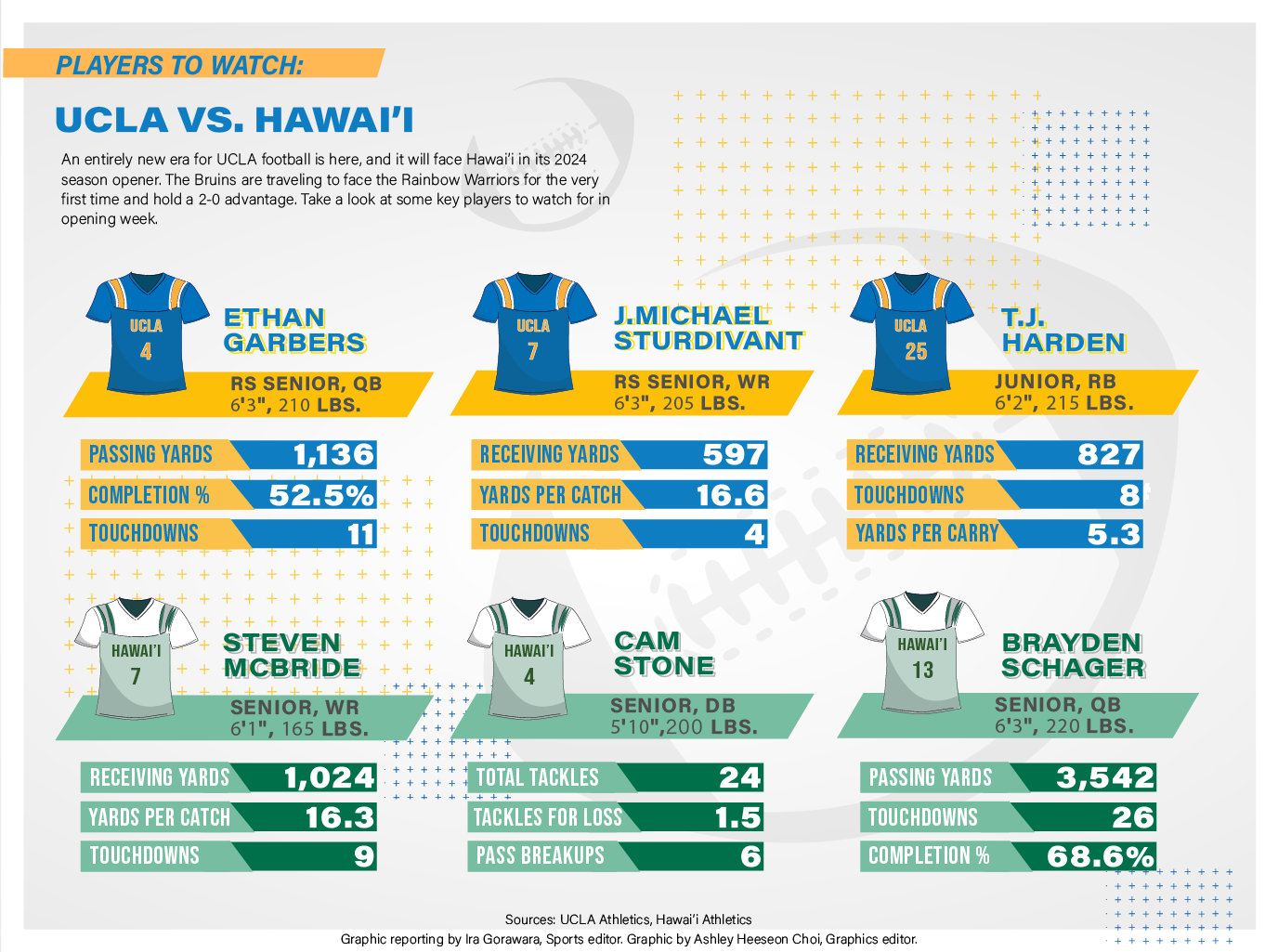Scouting Report: UCLA football vs. Hawai’i

By Noah Massey
Aug. 24, 2024 1:06 a.m.
This post was updated Aug. 25 at 9:09 p.m.
UCLA football will open its season against Hawai’i in Honolulu Aug. 31. The Bruins and Rainbow Warriors finished last season on opposite streaks, as the former came up short in three of their last five games while the latter cruised through their final matchups. Here is this week’s scouting report from contributor Noah Massey – who wishes he was in Hawaii right now.
Hawai’i’s Offense
Offensive Scheme: Run and Shoot
Run-pass percentage: 35% run, 65% pass
Strength: Passing volume
Weakness: Rushing
X-factor: QB Brayden Schager
Nobody passes as much as Hawai’i.
Last season, 65% of the plays run by the Rainbow Warriors were passing plays – the most in the country.
And it’s largely credited to third-year head coach Timmy Chang, who is the play caller for the only run-and-shoot offense in the nation. The unique attack works out of the shotgun formation a majority of the time and utilizes four wide receivers, constant motion and option routes that let receivers read the defense on the fly.
Quality and precision at the quarterback position is pivotal in such an offense. Quarterback Brayden Schager showed clear improvement last season, more than doubling his touchdown count and completing passes at an eight percent-higher clip than the year prior.
However, Schager’s statistical growth had a limited effect on an offense that remained near the bottom of the FBS in points per game – potentially due to its 804-yard decrease in rushing when compared to 2022.
Hawai’i averaged a mere three yards per rush – the 10th worst in the nation in 2023 – after a respectable 4.4 figure the year prior.
Schager – who averaged only a half yard per rush while attempting 40 more carries than any other Rainbow Warrior – was key to the team’s dismal figures on the ground. His 103 rushes include the 39 times he was sacked – which was sixth most in the nation.
The dynamic wide receiver tandem of Steven McBride and Pofele Ashlock have returned for another season after racking up a combined total of 1,856 yards and 18 touchdowns last season. However, McBride will remain on the sideline to start the season due to an undisclosed eligibility issue and is not listed on the depth chart for the team’s season opener Saturday.
Hawai’i’s one-dimensional offense resulted in tremendous scoring fluctuations last season, struggling to eclipse 10 points on three separate occasions – including when it was shut out by a San Jose State defense that allowed 25.8 points per game last year.
While Chang’s schemes have yet to find consistent success, UCLA’s lack of recent experience against the run and shoot could create problems.
Hawai’i’s Defense
Defensive Scheme: 4-2-5
Strength: Defensive Backs
Weakness: Defensive Line
X-factor: S Peter Manuma
First-year defensive coordinator Dennis Thurman’s resume is exceptional.
With 35 years of coaching experience – including 10 in the NFL – Thurman is bringing a tremendous amount of experience to Honolulu.
His approach is simple: blitzing and man-to-man defense, forcing discomfort through an aggressive defensive approach.
It remains to be seen how his new scheme will work with a defense that ranked 113th last season in points allowed per game and has largely unchanged personnel with just one transfer starter. On the bright side, the defense boasts an abundance of age and experience.
Safety Peter Manuma’s performance will be crucial in the success of the team’s defensive setup. The third-year defensive back enters the season with considerable success over the past two years, amassing 157 tackles and five interceptions.
Under Thurman’s systems, Manuma will likely be the last line of defense, preventing big plays in a blitz-heavy, man coverage formula.
Additionally, Hawai’i returned its four best corners in Virdel Edwards II, JoJo Forest, Caleb Brown and Cam Stone – who combined for 30 pass deflections last season – while adding USC transfer corner Fabian Ross.
While Thurman has emphasized his aggressive approach, the lack of quality pedigree on the defensive line may limit the effectiveness of his blitzes. Last season, no Rainbow Warrior surpassed 3.5 sacks, and the two defensive line transfers combined for two at their respective schools.
With a defense that looks all too similar to last year’s porous squad, Thurman has his work cut out for him in transforming this team into a respectable group.

